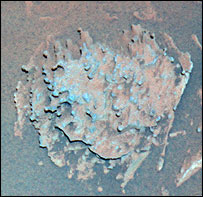Avi Blizovsky

"Pot of Gold" rock
Direct link to this page: https://www.hayadan.org.il/spirit300604.html
The Mars rover Spirit identified a hematite nugget in its semi-Mars location from its twin Opportunity which found the same mineral. Hematite is usually formed in the presence of water, mainly on Earth.
The discovery of Spirit was made in front of the Columbia Hills, in a strangely shaped rock known as the "Golden Pot" by NASA scientists.
The vehicle is now celebrating six months on Mars and its performance continues to delight NASA. The Spirit took a panoramic picture as well as micrographs of the rock.
The vehicle also examined the mineralogy of the rock in detail using two spectrometers. Now the scientists want to use the vehicle's digging systems to get inside as soon as they can maneuver the vehicle into the ideal position.
The scientists are trying to understand how the pot of gold got its strange shape. The rock looks like someone took a potato and stuck toothpicks in it, then placed jelly balls on the end of the toothpicks. said Steven Squires, lead scientist on the Mars Rover Project. "It's hard to guess why he got the eight shape. We don't even have a good theory." Squires said.
A more in-depth study of the pot of gold can help scientists assess what the discovery of hematite means about past environmental conditions. Hematite can be formed in several ways. Most of them require the presence of water, but it can also be the result of a dry thermal oxidation process." said Dr. Doug Ming, a member of the Mars rover science team. , we identified the hematite from space in the meridian plane, the opportunistic landing place. Then we learned that hematite is indeed part of the water story." Ming added.
Opportunity itself is on its way to a 130 meter wide crater that has been nicknamed Endurance Crater. As it goes deeper, it will continue to find more of the phosphoric salts scattered throughout the landing site. These salts, along with other evidence suggest to scientists that the vehicle landed on the shoreline of what was once a lake or sea.
The discovery of similar evidence in Endurance rocks deeper than those in Eagle Crater - which Endurance contains as a crater within a crater, may include clues about the amount of water that once covered this part of Mars.
According to Prof. Squires. ""I thought we would only find basalt under the layer of salt, but instead, the salt is everywhere we can see. Every time we see more and more sulfates, as we move down, it adds to the amount of water that was essential to create it.
For news at the BBC
Yedan Mars - special missions
https://www.hayadan.org.il/BuildaGate4/general2/data_card.php?Cat=~~~884505577~~~16&SiteName=hayadan
